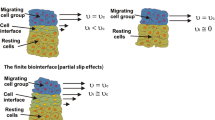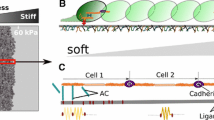Abstract
During collective cell migration, the intercellular forces will significantly affect the collective migratory behaviors. However, the measurement of mechanical stresses exerted at cell–cell junctions is very challenging. A recent experimental observation indicated that the intercellular adhesion sites within a migrating monolayer are subjected to both normal stress exerted perpendicular to cell–cell junction surface and shear stress exerted tangent to cell–cell junction surface. In this study, an interfacial interaction model was proposed to model the intercellular interactions for the first time. The intercellular interaction model-based study of collective epithelial migration revealed that the direction of cell migration velocity has better alignment with the orientation of local principal stress at higher maximum shear stress locations in an epithelial monolayer sheet. Parametric study of the effects of adhesion strength indicated that normal adhesion strength at the cell–cell junction surface has dominated effect on local alignment between the direction of cell velocity vector and the principal stress orientation, while the shear adhesion strength has little effect, which provides compelling evidence to help explain the force transmission via cell–cell junctions between adjacent cells in collective cell motion and provides new insights into “adhesive belt” effects at cell–cell junction.






Similar content being viewed by others
References
AnayaHernández A, RodríguezCastelán J, Nicolás L, MartínezGómez M, JiménezEstrada I, Castelán F, Cuevas E (2015) Hypothyroidism affects differentially the cell size of epithelial cells among oviductal regions of rabbits. Reprod Domest Anim 50:104–111
Anon E, Serra-Picamal X, Hersen P, Gauthier NC, Sheetz MP, Trepat X, Ladoux B (2012) Cell crawling mediates collective cell migration to close undamaged epithelial gaps. Proc Natl Acad Sci 109:10891–10896
Bazellières E et al (2015) Control of cell–cell forces and collective cell dynamics by the intercellular adhesome. Nat Cell Biol 17:409–420
Belytschko T, Chiapetta R, Bartel H (1976) Efficient large scale nonlinear transient analysis by finite elements. Int J Numer Methods Eng 10:579–596
Berdyyeva TK, Woodworth CD, Sokolov I (2004) Human epithelial cells increase their rigidity with ageing in vitro: direct measurements. Phys Med Biol 50:81
Bertet C, Sulak L, Lecuit T (2004) Myosin-dependent junction remodelling controls planar cell intercalation and axis elongation. Nature 429:667–671
Bi D, Lopez J, Schwarz J, Manning ML (2015) A density-independent glass transition in biological tissues. Nat Phys 11:1074–1079
Brodland GW, Viens D, Veldhuis JH (2007) A new cell-based FE model for the mechanics of embryonic epithelia. Comput Methods Biomech Biomed Eng Imaging 10:121–128
Brugués A et al (2014) Forces driving epithelial wound healing. Nat Phys 10:683–690
Butcher DT, Alliston T, Weaver VM (2009) A tense situation: forcing tumour progression. Nat Rev Cancer 9:108–122
Chen HH, Brodland GW (2000) Cell-level finite element studies of viscous cells in planar aggregates. J Biomech Eng 122:394–401
Collins C, Nelson WJ (2015) Running with neighbors: coordinating cell migration and cell–cell adhesion. Curr Opin Cell Biol 36:62–70
Das T, Safferling K, Rausch S, Grabe N, Boehm H, Spatz JP (2015) A molecular mechanotransduction pathway regulates collective migration of epithelial cells. Nat Cell Biol 17:276–287
De Paiva CS, Pflugfelder SC, Li DQ (2006) Cell size correlates with phenotype and proliferative capacity in human corneal epithelial cells. Stem Cells 24:368–375
Driessche W, Smet P, Raskin G (1993) An automatic monitoring system for epithelial cell height. Pflügers Arch Eur J Physiol 425:164–171
Du Roure O, Saez A, Buguin A, Austin RH, Chavrier P, Siberzan P, Ladoux B (2005) Force mapping in epithelial cell migration. Proc Natl Acad Sci USA 102:2390–2395
Edwards S, Yeomans J (2009) Spontaneous flow states in active nematics: a unified picture. EPL 85:18008
Fan H, Li S (2015a) Modeling microtubule cytoskeleton via an active liquid crystal elastomer model. Comput Mater Sci 96:559–566
Fan H, Li S (2015b) Modeling universal dynamics of cell spreading on elastic substrates. Biomech Model Mechanobiol 14:1265–1280
Farooqui R, Fenteany G (2005) Multiple rows of cells behind an epithelial wound edge extend cryptic lamellipodia to collectively drive cell-sheet movement. J Cell Sci 118:51–63
Farsad M, Vernerey FJ (2012) An XFEMbased numerical strategy to model mechanical interactions between biological cells and a deformable substrate. Int J Numer Meth Eng 92:238–267
Frascoli F, Hughes BD, Zaman MH, Landman KA (2013) A computational model for collective cellular motion in three dimensions: general framework and case study for cell pair dynamics. PLoS ONE 8:e59249
Friedl P, Hegerfeldt Y, Tusch M (2004) Collective cell migration in morphogenesis and cancer. Int J Dev Biol 48:441–449
Gagliardi PA et al (2015) Real-time monitoring of cell protrusion dynamics by impedance responses. Sci Rep 5:10206
Giepmans BN, van IJzendoorn SC (2009) Epithelial cell–cell junctions and plasma membrane domains. Biochim Biophys Acta Biomembr 1788:820–831
Grainger DW, Reichert A, Ringsdorf H, Salesse C, Davies DE, Lloyd JB (1990) Mixed monolayers of natural and polymeric phospholipids: structural characterization by physical and enzymatic methods. Biochim Biophys Acta Biomembr 1022:146–154
Guillot C, Lecuit T (2013) Mechanics of epithelial tissue homeostasis and morphogenesis. Science 340:1185–1189
Guz N, Dokukin M, Kalaparthi V, Sokolov I (2014) If cell mechanics can be described by elastic modulus: study of different models and probes used in indentation experiments. Biophys J 107:564–575
Hernandez S, Munguia BC, Gonzalez-Mariscal L (2007) ZO-2 silencing in epithelial cells perturbs the gate and fence function of tight junctions and leads to an atypical monolayer architecture. Exp Cell Res 313:1533–1547
Hunter AW, Barker RJ, Zhu C, Gourdie RG (2005) Zonula occludens-1 alters connexin43 gap junction size and organization by influencing channel accretion. Mol Biol Cell 16:5686–5698
Jacinto A, Wood W, Balayo T, Turmaine M, Martinez-Arias A, Martin P (2000) Dynamic actin-based epithelial adhesion and cell matching during Drosophila dorsal closure. Curr Biol 10:1420–1426
Kabla AJ (2012) Collective cell migration: leadership, invasion and segregation. J R Soc Interface 9:3268–3278
Kim JH et al (2013) Propulsion and navigation within the advancing monolayer sheet. Nat Mater 12:856–863
Lecaudey V, Gilmour D (2006) Organizing moving groups during morphogenesis. Curr Opin Cell Biol 18:102–107
Levental KR et al (2009) Matrix crosslinking forces tumor progression by enhancing integrin signaling. Cell 139:891–906
Li B, Sun SX (2014) Coherent motions in confluent cell monolayer sheets. Biophys J 107:1532–1541
Lin L, Zeng X (2017) Computational study of cell adhesion and rolling in flow channel by meshfree method. Comput Methods Biomech Biomed Eng 20:832–841
Lin L, Wang X, Zeng X (2014) Geometrical modeling of cell division and cell remodeling based on Voronoi tessellation method. CMES. Comput Model Eng Sci 98:203–220
Lin L, Samuel J, Zeng X, Wang X (2017a) Contribution of extrafibrillar matrix to the mechanical behavior of bone using a novel cohesive finite element model. J Mech Behav Biomed Mater 65:224–235
Lin L, Wang X, Zeng X (2017b) Computational modeling of interfacial behaviors in nanocomposite materials. Int J Solids Struct 115:43–52
Liu P, Zhang Y, Cheng Q, Lu C (2007) Simulations of the spreading of a vesicle on a substrate surface mediated by receptor-ligand binding. J Mech Phys Solids 55:1166–1181
Liu Z et al (2010) Mechanical tugging force regulates the size of cell–cell junctions. Proc Natl Acad Sci 107:9944–9949
Mayor R, Carmona-Fontaine C (2010) Keeping in touch with contact inhibition of locomotion. Trends Cell Biol 20:319–328
McGarry J, Murphy B, McHugh P (2005) Computational mechanics modelling of cell–substrate contact during cyclic substrate deformation. J Mech Phys Solids 53:2597–2637
Méhes E, Vicsek T (2014) Collective motion of cells: from experiments to models. Integr Biol 6:831–854
Mogilner A (2009) Mathematics of cell motility: have we got its number? J Math Biol 58:105–134
Montell DJ (2008) Morphogenetic cell movements: diversity from modular mechanical properties. Science 322:1502–1505
Park K et al (2010) Measurement of adherent cell mass and growth. Proc Natl Acad Sci 107:20691–20696
Patton DL, Thwin SS, Meier A, Hooton TM, Stapleton AE, Eschenbach DA (2000) Epithelial cell layer thickness and immune cell populations in the normal human vagina at different stages of the menstrual cycle. Am J Obstet Gynecol 183:967–973
Ponti A, Machacek M, Gupton SL, Waterman-Storer C, Danuser G (2004) Two distinct actin networks drive the protrusion of migrating cells. Science 305:1782–1786
Reig G, Pulgar E, Concha ML (2014) Cell migration: from tissue culture to embryos. Development 141:1999–2013
Rørth P (2009) Collective cell migration. Ann Rev Cell Dev 25:407–429
Roy S, Qi HJ (2010) A computational biomimetic study of cell crawling. Biomech Model Mechanobiol 9:573–581
Saez A, Ghibaudo M, Buguin A, Silberzan P, Ladoux B (2007) Rigidity-driven growth and migration of epithelial cells on microstructured anisotropic substrates. Proc Natl Acad Sci 104:8281–8286
Saez A et al (2010) Traction forces exerted by epithelial cell sheets. J Phys Condens Matter 22:194119
Scarpa E, Mayor R (2016) Collective cell migration in development. J Cell Biol 212:143–155
Schoen I, Hu W, Klotzsch E, Vogel V (2010) Probing cellular traction forces by micropillar arrays: contribution of substrate warping to pillar deflection. Nano Lett 10:1823–1830
Sepúlveda N, Petitjean L, Cochet O, Grasland-Mongrain E, Silberzan P, Hakim V (2013) Collective cell motion in an epithelial sheet can be quantitatively described by a stochastic interacting particle model. PLoS Comput Biol 9:e1002944
Shaw TJ, Martin P (2009) Wound repair at a glance. J Cell Sci 122:3209–3213
Sheetz MP, Felsenfeld DP, Galbraith CG (1998) Cell migration: regulation of force on extracellular-matrix-integrin complexes. Trends Cell Biol 8:51–54
Simpson KJ, Selfors LM, Bui J, Reynolds A, Leake D, Khvorova A, Brugge JS (2008) Identification of genes that regulate epithelial cell migration using an siRNA screening approach. Nat Cell Biol 10:1027–1038
Tambe DT et al (2011) Collective cell guidance by cooperative intercellular forces. Nat Mater 10:469–475
Trepat X, Fredberg JJ (2011) Plithotaxis and emergent dynamics in collective cellular migration. Trends Cell Biol 21:638–646
Trepat X, Wasserman MR, Angelini TE, Millet E, Weitz DA, Butler JP, Fredberg JJ (2009) Physical forces during collective cell migration. Nat Phys 5:426–430
Vasioukhin V, Bauer C, Yin M, Fuchs E (2000) Directed actin polymerization is the driving force for epithelial cell–cell adhesion. Cell 100:209–219
Vedula SRK, Ravasio A, Lim CT, Ladoux B (2013) Collective cell migration: a mechanistic perspective. Physiology 28:370–379
Vernerey FJ, Farsad M (2014) A mathematical model of the coupled mechanisms of cell adhesion, contraction and spreading. J Math Biol 68:989–1022
Vitorino P, Meyer T (2008) Modular control of endothelial sheet migration. Genes Dev 22:3268–3281
Weijer CJ (2009) Collective cell migration in development. J Cell Sci 122:3215–3223
Xu X-P, Needleman A (1994) Numerical simulations of fast crack growth in brittle solids. J Mech Phys Solids 42:1397–1434
Zeng X, Li S (2011a) Modelling and simulation of substrate elasticity sensing in stem cells. Comput Methods Biomech Biomed Eng 14:447–458
Zeng X, Li S (2011b) Multiscale modeling and simulation of soft adhesion and contact of stem cells. J Mech Behav Biomed Mater 4:180–189
Zeng X, Li S (2012) A three dimensional soft matter cell model for mechanotransduction. Soft Matter 8:5765–5776
Zeng X, Li S (2014) Biomechanical cell model by liquid-crystal elastomers. J Eng Mech 140:04013003
Acknowledgements
This work is supported by a grant from National Institutes of Health (Grant No. SC2GM112575) and a grant from the University of Texas at San Antonio (UTSA), Office of the Vice President for Research. Valuable discussions with Professor Jean Jiang and Professor Bruce Nicholson at Biochemistry Department of University of Texas Health Science Center at San Antonio, and with Professor Xiaodu Wang at Mechanical Engineering of UTSA are gratefully acknowledged.
Author information
Authors and Affiliations
Corresponding author
Ethics declarations
Conflict of interest
The authors declare that there is no conflict of interest.
Rights and permissions
About this article
Cite this article
Lin, L., Zeng, X. Numerical investigation of the role of intercellular interactions on collective epithelial cell migration. Biomech Model Mechanobiol 17, 439–448 (2018). https://doi.org/10.1007/s10237-017-0970-y
Received:
Accepted:
Published:
Issue Date:
DOI: https://doi.org/10.1007/s10237-017-0970-y




